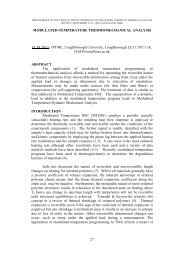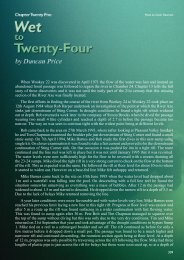WOOKEY HOLE - 75 years of cave diving & exploration - Sump4.com
WOOKEY HOLE - 75 years of cave diving & exploration - Sump4.com
WOOKEY HOLE - 75 years of cave diving & exploration - Sump4.com
You also want an ePaper? Increase the reach of your titles
YUMPU automatically turns print PDFs into web optimized ePapers that Google loves.
330<br />
<strong>WOOKEY</strong> <strong>HOLE</strong> - <strong>75</strong> YEARS OF CAVE DIVING & EXPLORATION<br />
Rick Stanton hails from Epping Forest in Essex and wanted to be a <strong>cave</strong> diver ever since he<br />
saw Underground Eiger (the film by Sid Perou <strong>of</strong> Oliver Statham and Ge<strong>of</strong>f Yeadon’s traverse<br />
from Kingsdale Master Cave to Keld Head) on TV in 1979. Rick recalls that it was his mother who<br />
suggested that he might be interested in the programme. Shortly afterwards, Rick went to Aston<br />
University where he simultaneously joined the caving club and sub-aqua club so as to fulfil his<br />
ambition.<br />
It was almost on the other side <strong>of</strong> the world, in Peru, that Rick met up with Ian Rolland on an<br />
Army Caving Association expedition in 1987. Ian was also a <strong>cave</strong> diver and had supported Rob<br />
Parker on his 1985 dive. Ian was very active in South Wales where he was busy pushing <strong>cave</strong><br />
passages beyond sumps in Og<strong>of</strong> Daren Cilau. Rick was invited to join Ian on his <strong>exploration</strong>s and<br />
they were very successful in discovering the Inca Trail (named after their Peru trip) extensions in<br />
the <strong>cave</strong>.<br />
I knew Ian as well, since we were both members <strong>of</strong> the Chelsea Speleological Society. Although<br />
I was born and brought up in Somerset, in the village <strong>of</strong> Chilcompton – only 12 miles from Wookey<br />
Hole – I had taken up scuba <strong>diving</strong> in my teens before being introduced to caving by a school friend<br />
during the summer vacation after my first year at Exeter University in 1983. During my postgraduate<br />
studies at Birmingham University I had spent far too much time digging in Agen Allwedd where Ian<br />
had helped out on occasion. One thing led to another, and I started <strong>cave</strong> <strong>diving</strong> as a means <strong>of</strong> getting<br />
to promising dig sites beyond sumps under the watchful tutelage <strong>of</strong> Ian Rolland and Martyn Farr.<br />
By 1990, I had moved to Coventry where I had a job with a major chemical company. Rick also<br />
worked in Coventry as a fire-fighter (he frequently turned up at my employers whenever the alarm<br />
went <strong>of</strong>f). Ian suggested that Rick and I should do some caving together, and we subsequently<br />
undertook the excavation <strong>of</strong> the Pwll-y-Cwm resurgence to the Llangattock <strong>cave</strong>s in the Clydach<br />
Gorge in order to establish a convenient ‘backdoor’. This facilitated further <strong>cave</strong> <strong>diving</strong> discoveries<br />
in Daren Cilau.<br />
John Volanthen and I first met in October 1998 when we went for an evening trip in Og<strong>of</strong> Capel.<br />
My <strong>diving</strong> watch was still set to British Summer Time and we ended up rushing out <strong>of</strong> the <strong>cave</strong><br />
only to find that we had an extra hour <strong>of</strong> drinking time. John comes from Brighton and first started<br />
caving with the Scouts in 1982. The surname ‘Volanthen’ is unusual, being an anglicised form <strong>of</strong> the<br />
family name <strong>of</strong> ‘Von Lanthen’ which was held by John’s Swiss grandfather. As a consequence John<br />
is frequently known by the affectionate nickname <strong>of</strong> ‘Volleyball.’ My dive logs show that whilst I<br />
did a fair amount <strong>of</strong> <strong>cave</strong> <strong>diving</strong> with Rick or John, it was not until the Wookey Hole dives described<br />
here, that the three <strong>of</strong> us got to work together.<br />
In 2002, Rick and John combined forces in order to push on from Rob Palmer’s upstream limit<br />
in Gough’s Cave. This required the use <strong>of</strong> a rebreather to ease the logistics and Rick was well-placed<br />
to be an expert in such technology, having been part <strong>of</strong> the 1998 <strong>exploration</strong>s to Wakulla Springs in<br />
Florida led by Bill Stone. The <strong>diving</strong> there had used sophisticated computer-controlled mixed-gas<br />
rebreathers, sonar underwater mapping devices mounted to long range diver propulsion vehicles<br />
and submersible decompression chambers borrowed from the marine oil <strong>exploration</strong> industry. It will<br />
not surprise readers to learn that Bill Stone is currently developing autonomous robotic underwater<br />
<strong>cave</strong> mappers for use in the sub-glacial lakes <strong>of</strong> Antarctica and beneath the ice-covered oceans <strong>of</strong><br />
Europa, one <strong>of</strong> Jupiter’s moons. Wookey Hole Cave Divers get everywhere!<br />
Rick’s rebreather, dubbed the RS2000, was less sophisticated, but nevertheless, most effective.<br />
He had put this together from various second-hand components during 2000. The RS2000 did the<br />
job in Gough’s Cave and Rick was able to surface in a blind airbell in the middle <strong>of</strong> the boulder<br />
choke at the end <strong>of</strong> Sump 3 first reached by Palmer in 1990.<br />
The proposed dive at the end <strong>of</strong> Wookey would require a more streamlined rebreather than<br />
the one used at Cheddar. Rick devised a novel side-mounted rebreather which could be worn like<br />
conventional <strong>cave</strong> <strong>diving</strong> cylinders rather than more traditional rebreathers which are commonly<br />
worn on the back (or chest). Interestingly, the concept <strong>of</strong> mounting a rebreather under one’s arm




